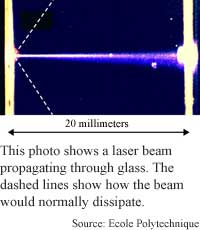
Laser
pulse penetrates glass
By
Kimberly Patch,
Technology Research NewsAs anyone familiar with laser pointers knows, a laser beam can travel a fairly long distance through air before the light spreads out enough to dissipate the red dot.
If you try pointing through a pane of glass, however, the red dot will dissipate completely before it gets to the other side.
A team of researchers from France has shown that it is possible, however, to push a very short pulse of laser light about a centimeter into a transparent solid using the same principles that allow laser beams to stay focused while they are traveling through air.
The researchers precisely focused femtosecond pulses of laser light very close to the front surface of a block of glass in order to "propagate a hairline laser beam... without the need of specially fabricated waveguides," said Stelios Tzortzakis, a research associate at Ecole Polytechnique in France. "The laser beam is self-guided." A femtosecond is one million billionth of a second.
Sending coordinated lightwaves a significant distance through solids before the light starts to break up is potentially useful in several ways, Tzortzakis said.
The technique could be used to further shorten laser pulses, which could speed optical communications. The experiments showed that a self-guided pulse can break into two or more shorter pulses as it goes through the glass. Optical communications use light pulses and the absence of pulses to represent the ones and zeros of digital information; shorter pulses mean more information can be transmitted in a given amount of time.
The ability to control tiny pulses of light as they pass through a solid could also eventually lead to circuits that use light to compute, he said. "Our work could probably give new design solutions," for all-optical circuits, Tzortzakis said. Current research efforts rely on waveguides, which are lines precisely etched in transparent material.
In both gases and solids, high-intensity laser pulses can travel long distances when two competing phenomena are perfectly balanced. First, the pulse changes the index of refraction of the medium it is traveling through. This can cause the medium to act like a lens that focuses, or converges the pulse further. At the same time, however, the high-intensity of the pulse ionizes some of the molecules around it, lowering the index of refraction, which causes the pulse to dissipate.
It was more difficult to find the right balance in a solid because light does not shine through solids as easily as it shines through gases, said Tzortzakis. The key is to focus the beam exactly, he said. "It is necessary to focus the femtosecond laser beam near the front surface of the sample with an adequate convergence. Too much or too little convergence is not effective," he said.
The results are interesting from a materials physics point of view, said Warren S. Warren, a chemistry professor at Princeton University. "Self-guiding pulses have been observed in gases before, but not this cleanly in solids," said Warren.
The technique could be applied to shorten laser pulses within two years, Tzortzakis said. Better understanding how laser pulses propagate through solids may help overcome some of the barriers to developing intense femtosecond lasers due to the damage the pulses cause to transparent optical elements, he said.
Applications in optical computing could take five or even 10 years, he added.
Tzortzakises research colleagues were Lionel Sudrie, Michel Franco, Bernard Prade, André Mysyrowicz, Arnaud Couairon and Luc Bergé of Ecole Polytechnique. They published the research in the November 19, 2001 issue of Physical Review Letters. The research was funded by the National School of Advanced Techniques (ENSTA) in France, the French National Center for Scientific Research (CNRS) the French Atomic Energy Authority (CEA).
Timeline: 5-10 years
Funding: University, Government
TRN Categories: Optical Computing; Optoelectronics and Photonics
Story Type: News
Related Elements: Technical paper, "Self-guided Propagation of Ultrashort IR Laser Pulses in Fused Silica," Physical Review Letters, November 19, 2001.
Advertisements:
January 9, 2002
Page One
Sunlight turns water to fuel
Search method melds results
VR tool keeps line of sight in hand
Laser pulse penetrates glass
Model tracks desert spread

News:
Research News Roundup
Research Watch blog
Features:
View from the High Ground Q&A
How It Works
RSS Feeds:
News
Ad links:
Buy an ad link
| Advertisements:
|
 |
Ad links: Clear History
Buy an ad link
|
TRN
Newswire and Headline Feeds for Web sites
|
© Copyright Technology Research News, LLC 2000-2006. All rights reserved.